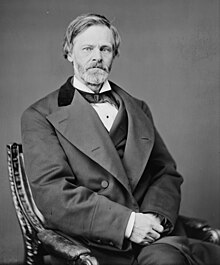John Sherman (Ohio)
| John Sherman | |
|---|---|
 |
|
| 35th United States Secretary of State | |
|
In office March 6, 1897 – April 27, 1898 |
|
| President | William McKinley |
| Preceded by | Richard Olney |
| Succeeded by | William R. Day |
| President pro tempore of the U.S. Senate | |
|
In office December 7, 1885 – February 26, 1887 |
|
| Preceded by | George F. Edmunds |
| Succeeded by | John James Ingalls |
|
United States Senator from Ohio |
|
|
In office March 4, 1881 – March 4, 1897 |
|
| Preceded by | Allen G. Thurman |
| Succeeded by | Mark Hanna |
|
In office March 21, 1861 – March 8, 1877 |
|
| Preceded by | Salmon P. Chase |
| Succeeded by | Stanley Matthews |
| 32nd United States Secretary of the Treasury | |
|
In office March 10, 1877 – March 3, 1881 |
|
| President | Rutherford B. Hayes |
| Preceded by | Lot M. Morrill |
| Succeeded by | William Windom |
| Member of the U.S. House of Representatives from Ohio's 13th district |
|
|
In office March 4, 1855 – March 21, 1861 |
|
| Preceded by | William D. Lindsley |
| Succeeded by | Samuel T. Worcester |
| Personal details | |
| Born |
May 10, 1823 Lancaster, Ohio, U.S. |
| Died | October 22, 1900 (aged 77) Washington, D.C., U.S. |
| Political party |
Republican Oppositionist Whig |
| Spouse(s) | Margaret Sarah Cecilia Stewart |
| Profession | Lawyer, politician |
| Signature | |
John Sherman (May 10, 1823 – October 22, 1900) was a politician from the U.S. state of Ohio during the American Civil War and into the late nineteenth century. A member of the Republican Party, he served in both houses of the U.S. Congress. He also served as Secretary of the Treasury and Secretary of State. Sherman sought the Republican presidential nomination three times, coming closest in 1888, but was never chosen by the party. His brothers included General William Tecumseh Sherman; Charles Taylor Sherman, a federal judge in Ohio; and Hoyt Sherman, an Iowa banker.
Born in Lancaster, Ohio, Sherman later moved to Mansfield, where he began a law career before entering politics. Initially a Whig, Sherman was among those anti-slavery activists who formed what became the Republican Party. He served three terms in the House of Representatives. As a member of the House, Sherman traveled to Kansas to investigate the unrest between pro- and anti-slavery partisans there. He rose in party leadership and was nearly elected Speaker in 1859. Sherman was elevated to the Senate in 1861. As a senator, he was a leader in financial matters, helping to redesign the United States' monetary system to meet the needs of a nation torn apart by civil war. After the war, he worked to produce legislation that would restore the nation's credit abroad and produce a stable, at home.
...
Wikipedia
